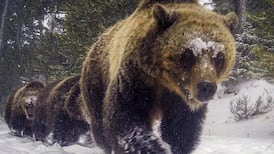In the hallway of Gearóid Cheaist Ó Catháin's house in Blackrock in Cork city is a framed, 60-year-old newspaper cutting of a young boy playing the fiddle. Above it reads the headline: "The loneliest boy in the world. He has only seagulls as playmates."
“How do they think of that stuff?” chuckles Ó Catháin, the now 66-year-old subject of that story.
He has just published a memoir called The Loneliest Boy in the World and jokes that if he writes a sequel he will call it "He Has Only Seagulls as Playmates". When the first newspaper article was written about him by Liam Robinson in 1948, he was the only child living on the Great Blasket Island. Five years later, in 1953, he was among the last 30 islanders evacuated and resettled by the Land Commission in Dunquin. He doesn't remember ever being lonely.
0 of 3
“It was the myth,” he says, shaking his head. “It’s the myth that an islander, a child on its own in a remote part of the world without any children to play with, is obviously lonely. But I can’t remember ever being lonely, to be honest.
“That reality is very hard to see from the outside, unless you went there and saw the child in an everyday existence. It was 30 people, a very small world, but I didn’t know anything else. I lived among them and did everything that they had to do. I tagged along with everything. I was a sort of grown-up before my time.”
This didn’t stop concerned well-wishers contacting him as his story spread across the world.
"I got sent lots of letters and books and toys," he says. "They came year upon year. As time went on, more photographers came to the Blaskets and took photographs [he was shy and didn't like this much]. There was even an offer from a Texas rancher who wanted to adopt me, to buy me, in other words, which obviously sounded ridiculous to my parents. Another family in America wanted to take the whole family over."
No trip to the Blaskets
I initially asked to meet Ó Catháin in Dunquin in order to go out to the Blaskets with him. He said he would prefer not to. He said the boat probably wouldn’t be sailing, and he was right: the seas were too rough.
“I don’t know how many more days I’d try to go out there,” he said.
So in the days before meeting him, I went to Dunquin, stared out at the wild, windswept islands, walked around the excellent exhibition at Blasket Centre, met its director, Micheál De Mórdha, and stayed in the B&B run by his wife, Angela.
From their window there is a clear, blue-skyed view of Inis Tuaisceart, or the Dead Man, as it is known, because it looks like a man lying on his back. “Though we had a visitor who said it looked more like a pregnant woman than a man,” says Angela. “I said, ‘You haven’t looked at many Irish men.’ ”
It's one of the strange contradictions of the Blasket Island people that, while they were one of the most remote isolated communities in Europe, they were also, from the 19th century on, strongly connected to an international world of literature, linguistics and anthropology.
A stream of scholars including Robin Flower, Carl Marstrander, George Thomson and Kenneth Jackson made their way there, drawn by the island's pure strand of Irish language and culture, and they encouraged islanders such as Peig Sayers, Micheál Ó Súilleabháin and Tomás Ó Criomhthain to write their life stories. Memoirs became the island's greatest export.
"When the scholars came they found the islanders spoke great literature and all they had to do was transfer that on to paper," says De Mórdha. "Then, when the other islanders saw this old geezer [Ó Criomhthain] there at the bottom of the village get away with writing about his life, they all said, 'Sure we all can do it', and it kicked off a literary avalanche. If you consider that there were never more than 180 people on the island in modern times, it's extraordinary that we have a Blasket library consisting of 40 original books written by the people or the visitors."
This world was coming to an end by the time Ó Catháin was born, and the ageing islanders were finding survival increasingly difficult. Shortly before his birth, the Great Blasket was visited by De Valera, and shortly afterwards the islanders sent him a panicked telegram: “Storm bound, distress, send food, nothing to eat.”
“There was no option but to leave,” says Ó Catháin. “A young man died the year before of meningitis, and the delay in going out in the coffin and burying him caused terrible problems. People got scared. They were getting old and the isolation started to get to a lot of them.”
New lives in Dunquin
When the islanders settled in their government-built houses in D
unquin, De Mórdha says they were well-known for their music and storytelling (“I often went to bed with the hairs standing up on the back of my head after listening to the stories”). He recalls how the men would still walk in single file, as they did on the cliffside paths on the island.
But the move was a shock for older islanders.
"A lot of them just curled up and died after leaving," says Ó Catháin. "I don't ever recollect my two grandfathers going to Dingle, which is just 30 or 40 miles away."
Did he feel different from other people? “An islander is a different animal from a mainlander. He’s isolated. There’s complete silence on the Blasket Islands, and that total silence and peace and tranquillity that’s associated with these remote areas has a fascination for people. For us as islanders, I suppose we didn’t really think about it, but we did stand out in the crowd. We weren’t great mixers when we went to the mainland. We went to Mass, we knew our friends and relations, and apart from going to Dingle to sell our sheep or fish or wool, we didn’t mix much really.”
The Land Commission had permitted the evacuees to keep their land, and in the 1970s an American investor began buying up parcels of it from them. Ó Catháin’s family resisted.
In 1984 Ó Catháin got a call saying: "There's an ad in the Wall Street Journal: 'Blasket Island for sale'."
A consortium soon had plans to build a luxury hotel there, and the Blasket Island Foundation was established in order to fight this development.
Ó Catháin became a patron and represented the islanders on the Gay Byrne Show. After this the Blasket Centre was built ("Nuala O'Faolain in The Irish Times said it looked like a day hospital," laughs De Mórdha) but most plans for the island were stalled amid decades of legal wrangling between private landowners and the State. Another patron of the foundation, Charles Haughey, went on to buy Inishvickillane himself. "But he felt like one of our own," says Ó Catháin.
I heard Inishvickillane was haunted, I say.
"You don't remember life without electricity, I presume?" says Ó Catháin. "There were an awful lot of folk tales about. There's a folk tale about a famous tune of the Blasket Islands called Port na bPúcaí. There was a couple living over on Inishvickillane, and in the middle of the night the lady was woken by this tune coming in the wind. [It was] a banshee who wasn't of this world, and they picked up the tune and they brought it back to the Great Blaskets, where it was associated with my father. He was supposed to be the person who could play it with the right poignancy and sadness."
‘Peig had great humanity’
Ó Catháin met Peig Sayers before she died and thinks some of her indomitable spirit got lost in translation and transcription. “Her autobiography comes across as dark and dreary but Peig had a great humanity,” he says. “She didn’t look like a woman wrapped up in insecurities and loneliness and hardship.”
Now retired in Cork city, having raised two children, it had never occurred to Ó Catháin to join the island's canon of memoir writers until, after contributing to a TG4 documentary, his co-writer Patricia Ahern got in touch to suggest it. Initially he resisted, "but gradually it dawned on me that I'd love to bring those people to life, the people I lived with for the five or six years there. In a lot of the books they don't exist. Nobody refers to them. Nobody knows who they are."
Was it difficult reliving it all?
“Oh it was terrible,” he says, without hesitation. “I thought I couldn’t cope with it at all. Patricia didn’t know how hard it was till we were finished. I found parts of it very hard to relate.”
Why? “Loneliness, I suppose. Talking about the people who were gone. There’s a certain poignancy and sadness to it. You’re bringing a community back to life. There are seven or eight other Blasket people still alive, but I’m the last of the evacuees.”
So it’s not just uncertain weather forecasts that keep him from the Blaskets now, he says. “My mother died in 2004 and really I don’t have much interest in going there,” he says, “because I’d have nobody to go there with. All my relations are dead. I’m the last surviving member of the 1953-1954 evacuation. Walking the Blaskets now, I think I’d feel lonely.”
The Loneliest Boy in the World: The Last Child of the Great Blasket Island by Gearóid Cheaist Ó Cathain with Patricia Ahern is published by The Collins Press






















